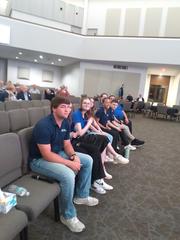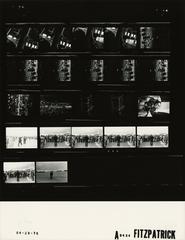Lubbock Lake Landmark: Comprehensive Guide to Visiting Hours, Tickets, and Historical Highlights
Date: 04/07/2025
Introduction
Lubbock Lake Landmark, nestled in the Yellowhouse Draw of Lubbock, Texas, stands as one of North America’s most significant archaeological and natural preserves. Documenting nearly 12,000 years of continuous human presence, environmental adaptation, and cultural evolution, the site serves as a living classroom and research hub for the Southern High Plains (Texas Beyond History; Wikipedia). Whether you are a history enthusiast, nature lover, or family in search of educational adventure, this guide details all you need to know—history, scientific discoveries, hours, admission, accessibility, and tips for making the most of your visit.
Table of Contents
- Early Human Presence and Environmental Context
- Discovery and Early Excavations
- Stratigraphy and Cultural Sequence
- Notable Archaeological Discoveries
- Preservation, Public Engagement, and Educational Impact
- Practical Visitor Information
- Ongoing Research and International Significance
- Community and Cultural Impact
- FAQ
- Visitor Tips
- Conclusion
- References
Early Human Presence and Environmental Context
Set within the ancient valley of Yellowhouse Draw, Lubbock Lake Landmark preserves a near-continuous record of human occupation and environmental change spanning from the Late Pleistocene to the present (Texas Beyond History). Water from the Ogallala Aquifer historically made this an oasis for both people and wildlife—especially during times of environmental stress.
Archaeological evidence shows the earliest inhabitants were Paleoindians, including the Clovis and Folsom cultures, who arrived as early as 13,000 years ago. These hunter-gatherers were drawn by abundant water and wildlife, including mammoths, giant bison, and camels (Rock & Gem). Over thousands of years, Archaic peoples, Native American tribes (such as the Apache and Comanche), and later Anglo-American settlers left their marks on the landscape.
Discovery and Early Excavations
Modern archaeological attention began in the 1930s when local efforts to restore the dried springs exposed deeply buried artifacts and faunal remains (Wikipedia). The first scientific excavations, led by the West Texas Museum (now Museum of Texas Tech University) and later the Texas Memorial Museum, uncovered bison bones and Folsom points dating to 10,800 years ago (TSHA Handbook; The Clio). These discoveries established the Landmark as a key site for understanding the earliest Americans.
Stratigraphy and Cultural Sequence
The Landmark’s stratigraphy—its sequence of soil and artifact layers—offers a rare, detailed timeline of human and ecological change (The Clio). Key periods include:
- Pleistocene Era: Layers with megafauna fossils and Paleoindian tools.
- Holocene Transition: Evidence of shifting climates and evolving subsistence strategies.
- Historic Period: Artifacts from 19th-century settlement, such as the Singer Store (1881), reflect the transformation to a modern community (TSHA Handbook).
This intact stratigraphy makes Lubbock Lake a benchmark for studies of North American prehistory.
Notable Archaeological Discoveries
Significant finds at Lubbock Lake Landmark include:
- Folsom and Clovis Projectile Points: Among the earliest artifacts in North America (Texas Beyond History).
- Charred Bison Bone Beds: Evidence of large-scale hunts and butchery, revealing social and survival strategies (The Clio).
- Megafauna Remains: Fossils of extinct species help reconstruct ancient environments (Lubbock TX Handyman).
- Historic Artifacts: Materials from the region’s first commercial enterprises and settlers (TSHA Handbook).
These finds are interpreted at the Robert A. Nash Interpretive Center, which offers engaging exhibits for visitors of all ages (Museum of Texas Tech University).
Preservation, Public Engagement, and Educational Impact
Managed by the Museum of Texas Tech University, the 336-acre preserve is open year-round and free to the public (Museum of Texas Tech University). With interpretive trails, exhibits, and educational programs, the Landmark serves thousands of students, families, and researchers annually. Visitors can observe summer excavations, take part in volunteer digs, and attend lectures or workshops (Lubbock TX Handyman). Artifacts are curated by Texas Tech and the Texas Archaeological Research Laboratory, ensuring long-term preservation (TSHA Handbook).
Practical Visitor Information
Visiting Hours
- Tuesday – Saturday: 9:00 AM – 5:00 PM
- Sunday: 1:00 PM – 5:00 PM
- Closed Mondays and major holidays
- Always check the official website for updates.
Admission and Tickets
- Admission: Free for all visitors
- Special programs/events: May require advance registration or a nominal fee
Accessibility
- Wheelchair accessible interpretive center and trails
- Assistance available upon request
Getting There and Parking
- Address: 2401 Landmark Drive, Lubbock, TX 79407
- Parking: Free on-site
Best Times to Visit
- Spring and Fall: Pleasant weather for outdoor activities
- Summer: Opportunities to observe active excavations
Guided Tours and Special Events
- Guided tours are offered seasonally and for groups by appointment
- Public events include workshops, night hikes, lectures, and hands-on archaeology days (The Tourist Checklist)
Nearby Attractions
- Buddy Holly Center
- Texas Tech University Museum
- Prairie Dog Town
Ongoing Research and International Significance
Since 1972, Lubbock Lake Landmark has hosted interdisciplinary research through the Quaternary Research Program (Museum of Texas Tech University; Archaeological Institute of America). Scientists and volunteers from around the world collaborate on excavations, mapping, and advanced dating techniques, contributing to our understanding of climate change, human migration, and megafaunal extinctions. Recognized as a National Historic Landmark and listed on the National Register of Historic Places, the site is a model for public archaeology (Wikipedia; Snoflo).
Community and Cultural Impact
Lubbock Lake Landmark is not just a research site; it’s a vital community hub. Through partnerships with schools, universities, and indigenous organizations, the site offers curriculum-aligned field trips, public lectures, and cultural festivals (chieftourist.com; ttuagriculturist.com). Monthly night hikes, hands-on archaeology days, and youth volunteer programs foster a deep connection between residents and their heritage (thetouristchecklist.com; thebrokebackpacker.com). The site’s efforts in preserving both natural habitats and indigenous history make it a cornerstone for local identity and intergenerational learning.
FAQ
Q: What are the current visiting hours?
A: Tuesday to Saturday, 9:00 AM–5:00 PM; Sunday, 1:00 PM–5:00 PM. Closed Mondays and major holidays.
Q: Is admission free?
A: Yes, general admission is free. Some special events may have fees.
Q: Are guided tours available?
A: Yes, seasonally and by appointment. See the official website for details.
Q: Is the site wheelchair accessible?
A: Yes, including paved trails and the interpretive center.
Q: Are pets allowed?
A: No, to protect sensitive habitats.
Q: Can visitors join archaeological digs?
A: Volunteer opportunities are offered during the summer field season.
Visitor Tips
- Dress for the weather and bring sun protection
- Carry water, especially in summer
- Take advantage of guided tours for expert insights
- Pair your visit with local attractions for a full day of discovery
- Download the Audiala app for interactive guides and updates
Conclusion
Lubbock Lake Landmark is a living testament to the resilience, ingenuity, and diversity of the Southern High Plains’ peoples. Its scientific discoveries, community programs, and accessible trails make it an essential destination for anyone seeking to connect with Texas’s deep past and dynamic present. Plan your visit, engage with the site’s resources, and become part of an ongoing story that continues to shape our understanding of North American history.
For the latest updates, visit the Museum of Texas Tech University’s Lubbock Lake Landmark website.
References and Further Reading
- Texas Beyond History
- Wikipedia
- Museum of Texas Tech University
- The Clio
- TSHA Handbook
- Rock & Gem
- Lubbock TX Handyman
- KCBD
- Snoflo
- chieftourist.com
- thetouristchecklist.com
- thebrokebackpacker.com
- ttuagriculturist.com
- Archaeological Institute of America
- Avelview
- WhichMuseum
- Lubbock Texas Tourism
- facts.net




